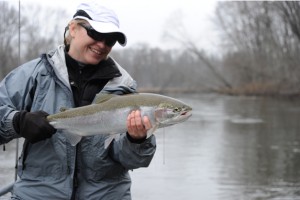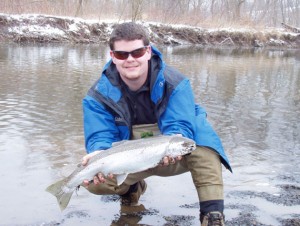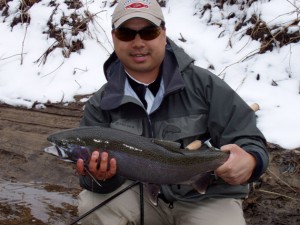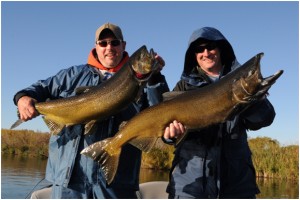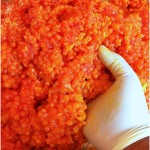A couple of days ago, I had a rare opportunity when one of our Wolfe Outfitters trips was cancelled at the last minute, and I had a free day. My Wolfe Outfitters guide, Matt, and I went fishing. We took Janice with us – the Recreation Manager at Crystal Mountain Resort, and the woman with whom I worked to create Wolfe Outfitters’ partnership with Crystal Mountain Resort.
A slight warming trend made for a nice day out on the water. Add in that we didn’t get to the ramp until after 10am, and we were relaxed and ready to go! Why not be more informal and relaxed when it comes to fun fishing? Janice even made our lunches the previous evening to be heated on Matt’s on-board grill.
November steelhead tend to relate to a few different patterns. Cured salmon eggs tied in spawn sacks and round-bodied crank baits dominate for gear anglers. Fly anglers have options such as beads, nymphs and streamers. Depending on water temperatures, the king salmon that run the rivers have likely ended their spawn, and the steelhead that gorge on the eggs in the river now have to find another food source to sustain them throughout the remainder of fall and winter.
The single egg pattern holds up well throughout winter, but it isn’t as effective as other techniques, as the salmon eggs are no longer prevalent in the river. However, spawn sacks offer tempting scent and life-like softness that even picky steelhead oftentimes just cannot pass up.
During the mid-fall period when the salmon have finished spawning, and the steelhead are still active with warmer water temperatures, throwing round-bodied crank baits can be an absolute blast. Similar to throwing longer bodied crank baits for king salmon, the technique is the same. Casts are made downstream, close to the bank and to cover (holding water). A medium retrieve, allowing the deep diving baits to work their magic as they are pulled through seams and creases induce violent strikes that anglers thoroughly enjoy. Medium weight rods are used to cushion these aggressive takes, yet have enough backbone to turn large steelhead away from logjams and snarly cover. For big steelhead on the Big Manistee River, I use 20 pound braided line, and either 14-pound fluorocarbon leaders or 12 pound, if the conditions are really clear and the flow is low. Fluorocarbon has the same refractive index as water, and is nearly invisible to fish. Steelhead often strike out of a feeding response, and looking as natural as possible is a huge advantage for my guide customers and me.
I’m glad that we were able to get out, even if it was for only 3 hours of fishing. We had a number of bites, and were able to land some beautiful Manistee River steelhead. And cooperatively mild weather made it all that much sweeter! It was nice to fish with good people, and experience the fun of fishing for oneself for a few hours. Does casting crank baits using spinning gear or casting flies for steelhead sound like fun? I can guarantee you that it is. And with one of the world’s premier steelhead fisheries at our doorstep, Wolfe Outfitters is ready to get you out on the water for your own adventure. Happily, I just had mine!





